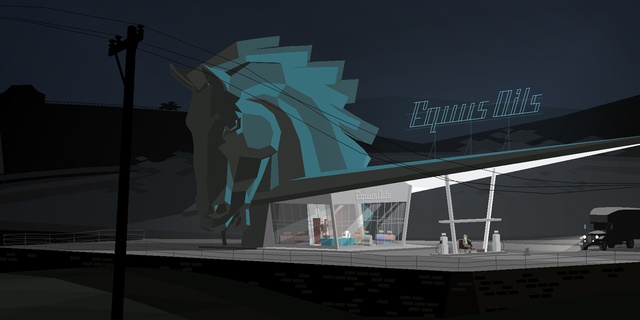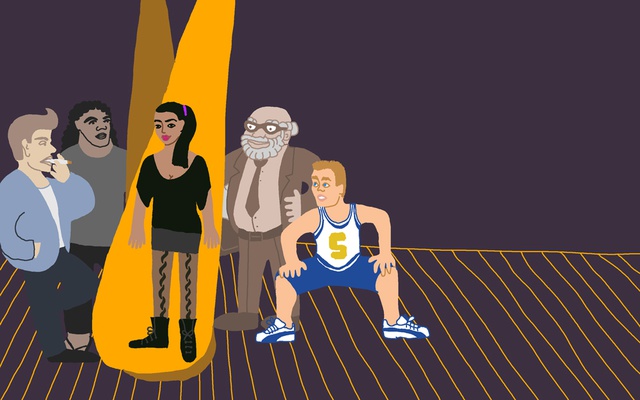From our guest editor: Where to begin - the intersection of games and theatre.
04.09.17
Hannah Nicklin, who has worked in both theatre and games, examines where the two art forms meet, and suggests some games for theatre-people to explore
Mainstream narratives about What Theatre Is and What Video Games Are often marr the perception of these kindred art forms (both derived from a common ground of formalised play). Many non-theatre goers think that theatre is all Shakespeare and Andrew Lloyd-Webber, while many non-gamers assume games are all guns-blazing first-person-shooters.
So, in case you’ve never seen anything but adverts for Call of Duty, ‘AAA’ or ‘triple A’ is the word for the blockbuster, billion-dollar industry level of game development. Think ‘Hollywood’. This is by no means a value judgment, rather one of scale and ambition. There are some great, slick action movies, westerns and romantic epics made by Hollywood, and also a lot of by-numbers forgettable stuff, but AAA and Hollywood share a scale of budget, studio size and ambition.
So there is a ‘AAA’ level of the games industry – your Assasain's Creed, Halo, Final Fantasy, etc. But just as you get Hollywood in film (and the West End in theatre), you also get the indie film industry (and the DIY and fringe performance scenes). That scale of production exists in games, too, which is often overlooked by people just starting to think about games and gaming.



There are many small studios, individual artists and collectives, making careful, challenging, experimental games in many different genres. Likewise, there is a queer, radical and often politically motivated global community of game designers, using games to talk about gender identity, racism, sexuality, politics, social change, capitalism and more abstract aesthetic concerns too.
There have been decade of experimentation with games, play and digital technology in performance: Blast Theory’s 1999 Desert Rain; Char Davies’ beautiful 1995 VR piece controlled through breath, Osmose; the work coming out of the Pervasive Media Studio in the late 2000s, the history of Fluxus, Dada and Happenings, all the way up to the DIY playful practices of the kind of artists who might have been programmed at Forest Fringe or Mayfest.
There are also many games and video games that can subvert what you might think games can be, and might push you to think about how you could make (or be involved in) games. I believe that before you can consider the intersection between performance and games, you need to understand what contemporary games are doing, and how they are doing it. We need to let go of the idea that we’re bringing greater artistic or cultural legitimacy to games and game design, and rather learn about how games are making art and culture already.
So, here are six games you can download and play, play online, or read about and watch videos of, which might help expand what you know games to be.
- 1) Kentucky Route Zero. Click here ($25, Mac, PC, Linux)
A five-act epic. The most traditional of these example games, it comes from the genre ‘point and click’, allowing you to investigate the screen of each scene, choose dialogue and make decisions to lead you onto the next part of the story using only your mouse. It’s a modern classic, an incredible soaring “magical realist” adventure through the belly of transience under late capitalism. It has an original score accompanied by old hymns and specially recorded bluegrass standards, careful writing, and an exquisite visual style. - 2) Bounden. Click here (£2.99 iOS, Android)
Made in collaboration between Game Oven and the Dutch National Ballet, this is a dancing game for two players and one iOS device. An invitation to consider how games can be pleasing in the hand and extend through the body. The two players hold the phone between them, and together they tilt the device around a virtual sphere; part choreography, part Twister. Click here - 3) Games for Protestors. Click here (free, website)
A collection of games largely collated by performance poet Harry Josephine Giles and agitprop game designer Molleindustria described as “to be played in the context of marches, rallies, occupations and other protests”. If you want to see where the legacy of Boal is being lived out today, head over and check out their site. - 4) Perfect Woman. Click here (Xbox Kinect, $8.99)
Perfect Woman by Peter Lu & Lea Schönfelder is a game “inspired by the ubiquitous personality questionnaires featured in women’s magazines and the female roles they define”. The Kinect is an addition to the Xbox that allows the console to see where the player is in the room. Perfect Woman takes you through different stages in a woman’s life where you must literally contort your body to mimic the poses of the character onscreen. The more perfect your contortion, the better you progress through life. A gestural satire. - 5) How to be a Blackbird. Click here (free, browser-based)
How to be a Blackbird is a small and perfectly formed Twine game from Holly Gramazio. Twine is a free tool that allows even those with little-to-no coding experience to make story-games. Twine has a huge community of text-based game designers making everything from fanfic to experimental literature (sometimes both!). - 6) The Tearoom - Robert Yang Click here (Mac, PC, Linux, name your own price)
Robert Yang did a brilliant interview with the Guardian about the assumptions of the male gaze in AAA first-person games and how he subverts it in this “historical public bathroom simulator”. Yang is simultaneously commenting on the historical policing of gay sex, and also – as he replaces the penises in this game with guns – the homophobic censorship of his games by certain distribution platforms. Yang writes on his blog “decades of male heterosexual hegemony have trained gamers into thinking of ‘looking’ as a ‘free’ action, with few consequences or results.” This is a game that challenges those assumptions.
That’s a whirlwind tour of some independent, experimental and creative explorations of the affordances of games. Very few of them require access to a console or fluency with controllers, and even just watching videos of them in action will hopefully broaden your experience of what’s going in the lesser-known parts of the world of video games.
I was asked to write about the intersection between theatre and games, but honestly, I think we have to start before that. Most projects I see in performance that attempt to engage with games aren’t intersecting – they don’t understand enough about the qualities and affordances of games, they’re just adding digital components, and working with any-game-designer. They are rarely collaborating in meaningful and equal terms with artists who are responding to the same ideas and themes.
For this reason I wrote the above as a starting point for anyone involved in performance interested in the places where games and performance can intersect. I invite you to learn what great art is already being made in these communities, and to then find collaborators and places where they might intersect. I then can suggest three next steps:
- 1) Read Steve Dixon’s Digital Performance, which is an incredible account of the past century of new media in performance, including dance, VR, early internet art, right up to Blast Theory’s Desert Rain.
- 2) Go to Beta Public, a roughly annual festival of video games and performance run by Patrick Ashe and Thomas Martin at Camden People’s Theatre (and the V&A later this year), showcasing a selection of performative video games alongside performance talks and theatre works with a playful/games influence. Other semi-annual or past events with great lineups of experimental games include: Now Play This at Somerset House in London, AMAZE in Berlin, Fantastic Arcade in Austin TX, Milano Games Festival in Italy, and Kokoromi’s GAMMA exhibitions.
- 3) And finally, if you feel at a loss as to how to engage critically with a game like you would a piece of performance, a great article to read is Hunicke, Leblanc and Zubek’s 2004 paper MDA: A Formal Approach to Game Design and Game Research, which breaks games down into an aesthetic (the ‘feel’ of a game), mechanics (the rules or ‘verbs’ of the game), and dynamics (how players use those rules).
The playful arts are an ancient form, and videogames can rightly be considered to be a part of playful art history. Ask not what videogames can do for you, but what you can do with videogames.
Hannah Nicklin is a writer, game designer, academic, producer and artist who has been working at the confluence of performance writing, community-based practices and game design for the past 10 years. She has a PhD in games influenced theatre and theatre influenced games. She makes works of art, games and installations that find the best way to ask people to engage with a story.
Credits include: The RSC, The V&A, RPS, Wellcome Collection, The BBC, Twisted Tree Games (Ed Key), Mutazione (Die Gute Fabrik), Hide & Seek, Coney, Now Play This, Feral Vector, Gamecity and Goldsmith’s University.



